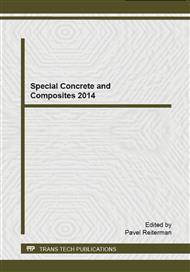[1]
B. Lothenbach, K. Scrivener, R.D. Hooton: Supplementary cementitious materials; Cement and Concrete Research, 41 (2011) 1244-1256.
DOI: 10.1016/j.cemconres.2010.12.001
Google Scholar
[2]
Karen L. Scrivener, André Nonat: Hydration of cementitious materials, present and future; Cement and Concrete Research, 41 (2011) 651-665.
DOI: 10.1016/j.cemconres.2011.03.026
Google Scholar
[3]
E. Vejmelková, M. Pavlíková, M. Keppert, Z. Keršner, P. Rovnaníková, M. Ondráček, M. Sedlmajer, R. Černý: Fly-Ash Influence on the Properties of High Performance Concrete; Cement Wapno Beton 13/75, (2009) 189-204.
DOI: 10.1016/j.conbuildmat.2010.01.017
Google Scholar
[4]
T. K. Erdem, G. Tayfur, Ö. Kirca: Experimental and modelling study of strength of high strength concrete containing binary and ternary binders; Cement Wapno Beton 16/78, April 2011, Pages 224-237.
Google Scholar
[5]
E. Vejmelková, M. Keppert, S. Grzeszczyk, B. Skaliński, R. Černý: Properties of Self-Compacting Concrete Mixtures Containing Metakaolin and Blast Furnace Slag. Construction and Building Materials, Volume 25, Issue 3, March 2011, Pages 1325-1331.
DOI: 10.1016/j.conbuildmat.2010.09.012
Google Scholar
[6]
Franco Massazza: 10 - Pozzolana and Pozzolanic Cemen, Lea's Chemistry of Cement and Concrete (Fourth Edition), 2003, Pages 471-635.
DOI: 10.1016/b978-075066256-7/50022-9
Google Scholar
[7]
Máca, P., Jandeková, D., Konvalinka, P.: The influence of metakaolin addition on the scaling of concrete due to frost action; Cement Wapno Beton, 19 (2014) 1-7.
Google Scholar
[8]
Máca, P., Jandeková, D., Sovják, R., Konvalinka, P.: Increasing concrete resistance to deicing chemicals by using metakaolin; Life-Cycle and Sustainability of Civil Infrastructure Systems, CRC Press/Balkema, Leiden, (2012) 1348-1352.
Google Scholar
[9]
Konvalinka, P., Litoš, J., Jandeková, D.: Volume Changes of Cement Pastes Using Metakaolin; Proceedings of the 50th Annual Conference on Experimental Stress Analysis, Czech Technical University in Prague, Praha, (2012) 211-216.
Google Scholar
[10]
Reiterman, P., Keppert, M., Čáchová, M., Holčapek, O., Vogel, F., Kolář, K., Konvalinka, P., 2014, Permeability and basic physical properties of concrete with metakaolin addition, Applied Mechanics and Materials, Vol. 486, pp.313-318.
DOI: 10.4028/www.scientific.net/amm.486.313
Google Scholar
[11]
E. Vejmelková, M. Pavlíková, M. Keppert, Z. Keršner, P. Rovnaníková, M. Ondráček, M. Sedlmajer, R. Černý, High Performance Concrete with Czech Metakaolin: Experimental Analysis of Strength, Toughness and Durability Characteristics. Construction and Building Materials 24 (2010).
DOI: 10.1016/j.conbuildmat.2010.01.017
Google Scholar
[12]
Product data sheet: Mefisto L05, České lupkové závody, a. s. ©(2013).
Google Scholar
[13]
Roels, S., Carmeliet. J., Hens. H., Adan. O., Brocken, H., Černý, R., Pavlík, Z., Hall, C., Kumaran, K., Pel, L., Plagge, R. Interlaboratory Comparison of Hygric Properties of Porous Building Materials, Journal of Thermal Envelope and Building Science 27 (2004).
DOI: 10.1177/1097196304042119
Google Scholar
[14]
ČSN EN 1015-11: Methods of test for mortar for masonry - Part 11: Determination of flexural and compressive strentgth of hardened mortar, Prague, Czech Standardization Institute, (2000).
DOI: 10.3403/01905442
Google Scholar
[15]
ČSN 72 7031: Determination of water vapour diffusion coefficient of building materials by method without temperature gradient, (2001).
Google Scholar
[16]
M. K. Kumaran: Moisture Diffusivity of Building Materials from Water Absorption Measurements, Journal of Thermal Envelope and Building Science, 22 (1999) 349-355.
DOI: 10.1177/109719639902200409
Google Scholar
[17]
R. Černý, P. Rovnaníková: Transport processes in concrete; Spon Press, London (2002).
Google Scholar


